#claudio inverno
Text
youtube
Jane Eyre (1996), directed by Franco Zeffirelli
Inverno a Lowood, original soundtrack by Claudio Capponi and Alessio Vlad
#Jane Eyre#Jane Eyre 1996#Franco Zeffirelli#Claudio Capponi#Alessio Vlad#ost#soundtrack#inverno a lowood#Youtube
1 note
·
View note
Text
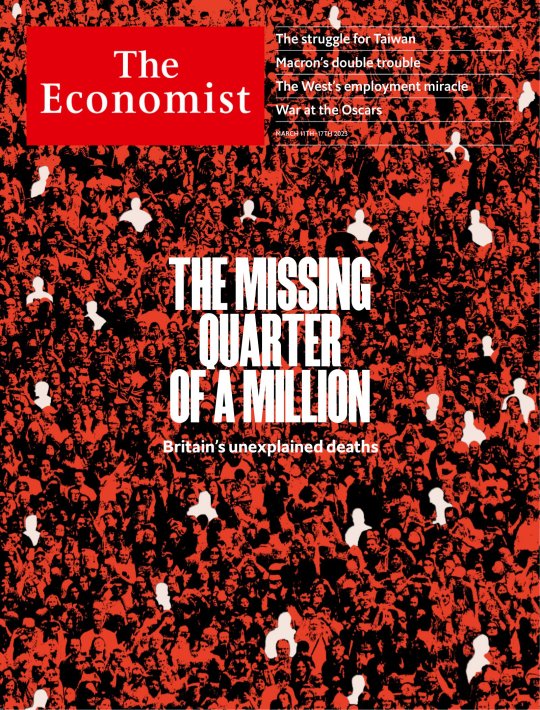
Falta explicar o mistério dos 250.000 mortos SÓ na Inglaterra
Se só a Grã-Bretanha teve 250.000 mortes prematuras em uma década, segundo o The Economist, quantos já não teriam morrido em países menos desenvolvidos?
Por Cláudio Suenaga
A notícia não é de um blog de teorias da conspiração. Foi publicada na edição de 11 a 17 de março da sóbria, tradicional e prestigiosa revista semanal de assuntos internacionais The Economist, fundada por James Wilson em setembro de 1843.
Nos anos recentes, diz a The Economist, a Grã-Bretanha foi atingida por uma crise de saúde após a outra. Primeiro veio a pandemia de Divoc, depois os atrasos na saúde e na assistência social que o coronavírus exacerbou e um longo inverno de greves e departamentos de emergência sobrecarregados.
Mas, no fundo, muito antes da pandemia, uma história ainda mais perturbadora se desenrolou. A Grã-Bretanha passou por uma década sombria durante a qual talvez um quarto de milhão de pessoas morreram antes do esperado, isso mesmo.
Pelos cálculos oficiais, esse é o número de mortes extras que a Grã-Bretanha sofreu, em comparação com países semelhantes, como França e Dinamarca.
A razão é que, no início da década de 2010, a expectativa de vida estagnou na Grã-Bretanha em comparação com as tendências de longo prazo e em outros países. Essa desaceleração da expectativa de vida atingiu todas as faixas etárias, não apenas os idosos. E afetou desproporcionalmente os pobres.
Se você viajar apenas 10 km (seis milhas) da parte mais elegante de Kensington, em Londres, até New Cross Gate, a expectativa de vida dos homens cai em impressionantes 18 anos, de 92 para 74. O fardo que essas mortes impõem aos vivos não é apenas pesado em luto. Quando mais pessoas estão morrendo e a expectativa de vida está estagnada, um número maior de pessoas também vive com problemas de saúde.
E estamos falando da Grã-Bretanha, a sexta maior economia do mundo com um PIB estimado de US$ 3,13 trilhões em 2023, aquele que já foi o maior império na história da humanidade, chegando a dominar quase um quarto do planeta, tanto que seu território foi chamado de “O Império no qual o Sol nunca se põe”.
O que se passa em países do terceiro, quarto e quinto mundos? Teríamos aí um gap de muitos milhões de mortos a ser explicado, mas que certamente só ficarão nas estatísticas. Como diz o velho adágio, o que não se pode ou não se quer explicar, “a terra encobre”.
Torne-se o meu patrono no Patreon e tenha acesso a esta matéria completa bem como a dezenas de conteúdos exclusivos: https://www.patreon.com/posts/82944406
🎬 Seja membro de meu Canal no YouTube e receba benefícios:
Vamos migrar em massa para o Rumble! Inscreva-se por lá no meu canal:
Registre-se aqui: https://rumble.com/register/suenaga/
Site Oficial: https://claudiosuenaga.yolasite.com
Leia e baixe aqui todos os meus trabalhos gratuitamente: https://suenagadownloads.yolasite.com/
Blog Oficial: https://www.claudiosuenaga.com.br/
ou https://lastdrinkinthedesertofthereal.tumblr.com/
Medium: https://medium.com/@helpsuenaga
Facebook (perfil): https://www.facebook.com/ctsuenaga
Facebook (página Expondo a Matrix): https://www.facebook.com/clasuenaga
Instagram: https://www.instagram.com/claudiosuenaga
Pinterest: https://br.pinterest.com/claudiosuenaga
Twitter: https://twitter.com/suenaga_claudio
GETTR: https://gettr.com/user/suenaga
E-mail: [email protected]
✅ Adquira “Encuentros cercanos de todo tipo. El caso Villas Boas y otras abducciones íntimas”, meu primeiro livro traduzido em espanhol, na Amazon:
Amazon.com (envios a todo o mundo desde os EUA): https://amzn.to/3Lh93Lb
Amazon.es (envios a todo o mundo desde a Espanha): https://amzn.to/3LlMtBn
Amazon.co.uk (envios dentro do Reino Unido): https://www.amazon.co.uk/-/es/Cl%C3%A1udio-Tsuyoshi-Suenaga/dp/B0BW344XF1/
Amazon.de (envios dentro da Alemanha): https://www.amazon.de/-/es/Cl%C3%A1udio-Tsuyoshi-Suenaga/dp/B0BW344XF1/
Amazon.fr (envios dentro da França): https://www.amazon.fr/-/es/Cl%C3%A1udio-Tsuyoshi-Suenaga/dp/B0BW344XF1/
Amazon.it (envios dentro da Itália): https://www.amazon.it/-/es/Cl%C3%A1udio-Tsuyoshi-Suenaga/dp/B0BW344XF1/
Amazon.co.jp (envios dentro do Japão): https://www.amazon.co.jp/-/es/Cl%C3%A1udio-Tsuyoshi-Suenaga/dp/B0BW344XF1/
Adquira aqui meu livro “As Raízes Hebraicas da Terra do Sol Nascente: O Povo Japonês Seria uma das Dez Tribos Perdidas de Israel?”
6 notes
·
View notes
Text
Guarda "CLAUDIO BAGLIONI / Sisto V / VIDEO" su YouTube
youtube
9) SISTO V*
Quasi che fusse inverno
Sisto fa foco e fiamme tutt'intorno
Quasi che fusse già venuto inverno
Dice che ce prepara al callo dell'inferno
Sisto Sisto mio
Sisto Sisto mio
Dice che ce prepara al callo dell'inferno
Fijo meno giùdizzio
E più fede comanna er Santo Uffizio
E tiè 'sta maledetta lingua a posto
Si tu non voi finì come 'n capretto arrosto
Fijo fijo mio
Fijo fijo mio
Si tu non voi finì come 'n capretto arrosto
Dacce un papa mijore
M'ariccomanno a te nostro Signore
Un quarchiduno che 'gne piace er foco
Uno che c'ami, preghi tanto e campi poco
O Signore Iddio
O Signore Iddio
Uno che c'ami, preghi tanto e campi poco.
(*Testo scritto in dialetto romano)
Compositori: Claudio Baglioni / Antonio Coggio
Testo di Sisto V © Universal Music Publishing Ricordi Srl.
3 notes
·
View notes
Text

09/12 Happy Birthday Dylan 30 Years fa ballare Bolgia - Bergamo
Sabato 9 dicembre 2023 al Bolgia di Bergamo va in scena un party imperdibile per chi ama le sonorità elettroniche più potenti: è Happy Birthday Dylan 30 Years. Si festeggiano 30 anni di vita, volti e successi di un evento leggendario. Facile, dunque, intuire che si tratta di un'altra notte memorabile, l'ennesima della stagione autunno - inverno - primavera 2023/4.
Dylan è infatti uno dei simboli dell'elettronica in Italia e non solo. Il party al Bolgia di Bergamo il 9 dicembre '23 è dedicato alle sonorità techno ed hardcore che fanno muovere a tempo il mondo. E, anche per il 30esimo compleanno, il club prediletto è il Bolgia. E qui si sceglie tra due console, entrambe con una line-up pazzesca.
Protagonista, in Main Room, è il top dj producer Tatanka. Pioniere dell'elettronica, il suo nome d'arte, nella lingua degli indiani d'America, vuol dire bisonte. Classe '79, ligure, fa scatenare i club di mezzo mondo da oltre 25 anni e, dal '98 ad oggi, ha pubblicato decine di produzioni e remix e fatto ballare eventi di livello mondiale. "Diap", in compagnia di Roberto Molinaro, è il suo singolo più recente, manifesto di uno stile unico ed intramontabile. C'è poi in console al Bolgia anche Paolo Kighine, colonna della scena techno italiana il cui nome è legato ad Insomnia Discoacropoli d'Italia. A chiudere il cerchio in grande stile ecco Cecco Dj, Micky Vi, Juri Carrera, la voce leggendaria di Roberto Francesconi e quella di Mr Fudo. L'intro è di Pero G.
Durante la stessa notte si balla anche nella Hardcore - Frenchcore Room con il sound scatenato dell'italiana Sakyra, classe 1998, in pista dal 2017, e già protagonista dei club dei festival più importanti d'Europa come Harmony Of Hardcore o Tomorrowland. Non può mancare Claudio Lancinhouse: in console dai primi anni '90, è un simbolo della scena techno & hardcore italiana. Al mixer anche Frenchkillerz, Monlight, Faster vs Danez, Ivan Gabber vs The Cannibal e The Game Master. Il Bolgia apre alle ore 23.30 e si balla fino alle 5 del mattino.
L'appuntamento di sabato 9 dicembre 2023 al Bolgia di Bergamo con Happy Birthday Dylan 30 Years è solo l'ennesimo importante per il top club sull'A4. Tra gli altri, si sono esibiti qui negli ultimi mesi top dj come Chris Liebing, Len Fake, Sam Paganini, Indira Paganotto, I HATE MODELS, KLANGKUENSTLER, Nastia, Ilario Alicante, Alignment, RBX, Marika Rossail, Charlie Sparks e TRYM, Luca Agnelli, Deborah De Luca, SNTS e Regal, Tita Lau, 999999999 e Lokier o Patrick Mason + Valentinø.
09/12 Happy Birthday Dylan 30 Years @ Bolgia - Bergamo
Bolgia - Bergamo
via Vaccarezza 9, Osio Sopra (Bergamo) A4: Dalmine
info: 338 3624803, dalle 23.30 alle 6 del mattino
0 notes
Text

09/12 Happy Birthday Dylan 30 Years fa ballare Bolgia - Bergamo
Sabato 9 dicembre 2023 al Bolgia di Bergamo va in scena un party imperdibile per chi ama le sonorità elettroniche più potenti: è Happy Birthday Dylan 30 Years. Si festeggiano 30 anni di vita, volti e successi di un evento leggendario. Facile, dunque, intuire che si tratta di un'altra notte memorabile, l'ennesima della stagione autunno - inverno - primavera 2023/4.
Dylan è infatti uno dei simboli dell'elettronica in Italia e non solo. Il party al Bolgia di Bergamo il 9 dicembre '23 è dedicato alle sonorità techno ed hardcore che fanno muovere a tempo il mondo. E, anche per il 30esimo compleanno, il club prediletto è il Bolgia. E qui si sceglie tra due console, entrambe con una line-up pazzesca.
Protagonista, in Main Room, è il top dj producer Tatanka. Pioniere dell'elettronica, il suo nome d'arte, nella lingua degli indiani d'America, vuol dire bisonte. Classe '79, ligure, fa scatenare i club di mezzo mondo da oltre 25 anni e, dal '98 ad oggi, ha pubblicato decine di produzioni e remix e fatto ballare eventi di livello mondiale. "Diap", in compagnia di Roberto Molinaro, è il suo singolo più recente, manifesto di uno stile unico ed intramontabile. C'è poi in console al Bolgia anche Paolo Kighine, colonna della scena techno italiana il cui nome è legato ad Insomnia Discoacropoli d'Italia. A chiudere il cerchio in grande stile ecco Cecco Dj, Micky Vi, Juri Carrera, la voce leggendaria di Roberto Francesconi e quella di Mr Fudo. L'intro è di Pero G.
Durante la stessa notte si balla anche nella Hardcore - Frenchcore Room con il sound scatenato dell'italiana Sakyra, classe 1998, in pista dal 2017, e già protagonista dei club dei festival più importanti d'Europa come Harmony Of Hardcore o Tomorrowland. Non può mancare Claudio Lancinhouse: in console dai primi anni '90, è un simbolo della scena techno & hardcore italiana. Al mixer anche Frenchkillerz, Monlight, Faster vs Danez, Ivan Gabber vs The Cannibal e The Game Master. Il Bolgia apre alle ore 23.30 e si balla fino alle 5 del mattino.
L'appuntamento di sabato 9 dicembre 2023 al Bolgia di Bergamo con Happy Birthday Dylan 30 Years è solo l'ennesimo importante per il top club sull'A4. Tra gli altri, si sono esibiti qui negli ultimi mesi top dj come Chris Liebing, Len Fake, Sam Paganini, Indira Paganotto, I HATE MODELS, KLANGKUENSTLER, Nastia, Ilario Alicante, Alignment, RBX, Marika Rossail, Charlie Sparks e TRYM, Luca Agnelli, Deborah De Luca, SNTS e Regal, Tita Lau, 999999999 e Lokier o Patrick Mason + Valentinø.
09/12 Happy Birthday Dylan 30 Years @ Bolgia - Bergamo
Bolgia - Bergamo
via Vaccarezza 9, Osio Sopra (Bergamo) A4: Dalmine
info: 338 3624803, dalle 23.30 alle 6 del mattino
0 notes
Text
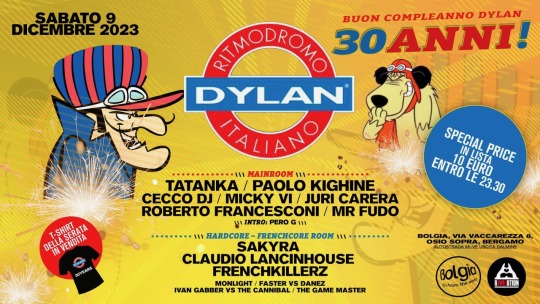
09/12 Happy Birthday Dylan 30 Years fa ballare Bolgia - Bergamo
Sabato 9 dicembre 2023 al Bolgia di Bergamo va in scena un party imperdibile per chi ama le sonorità elettroniche più potenti: è Happy Birthday Dylan 30 Years. Si festeggiano 30 anni di vita, volti e successi di un evento leggendario. Facile, dunque, intuire che si tratta di un'altra notte memorabile, l'ennesima della stagione autunno - inverno - primavera 2023/4.
Dylan è infatti uno dei simboli dell'elettronica in Italia e non solo. Il party al Bolgia di Bergamo il 9 dicembre '23 è dedicato alle sonorità techno ed hardcore che fanno muovere a tempo il mondo. E, anche per il 30esimo compleanno, il club prediletto è il Bolgia. E qui si sceglie tra due console, entrambe con una line-up pazzesca.
Protagonista, in Main Room, è il top dj producer Tatanka. Pioniere dell'elettronica, il suo nome d'arte, nella lingua degli indiani d'America, vuol dire bisonte. Classe '79, ligure, fa scatenare i club di mezzo mondo da oltre 25 anni e, dal '98 ad oggi, ha pubblicato decine di produzioni e remix e fatto ballare eventi di livello mondiale. "Diap", in compagnia di Roberto Molinaro, è il suo singolo più recente, manifesto di uno stile unico ed intramontabile. C'è poi in console al Bolgia anche Paolo Kighine, colonna della scena techno italiana il cui nome è legato ad Insomnia Discoacropoli d'Italia. A chiudere il cerchio in grande stile ecco Cecco Dj, Micky Vi, Juri Carrera, la voce leggendaria di Roberto Francesconi e quella di Mr Fudo. L'intro è di Pero G.
Durante la stessa notte si balla anche nella Hardcore - Frenchcore Room con il sound scatenato dell'italiana Sakyra, classe 1998, in pista dal 2017, e già protagonista dei club dei festival più importanti d'Europa come Harmony Of Hardcore o Tomorrowland. Non può mancare Claudio Lancinhouse: in console dai primi anni '90, è un simbolo della scena techno & hardcore italiana. Al mixer anche Frenchkillerz, Monlight, Faster vs Danez, Ivan Gabber vs The Cannibal e The Game Master. Il Bolgia apre alle ore 23.30 e si balla fino alle 5 del mattino.
L'appuntamento di sabato 9 dicembre 2023 al Bolgia di Bergamo con Happy Birthday Dylan 30 Years è solo l'ennesimo importante per il top club sull'A4. Tra gli altri, si sono esibiti qui negli ultimi mesi top dj come Chris Liebing, Len Fake, Sam Paganini, Indira Paganotto, I HATE MODELS, KLANGKUENSTLER, Nastia, Ilario Alicante, Alignment, RBX, Marika Rossail, Charlie Sparks e TRYM, Luca Agnelli, Deborah De Luca, SNTS e Regal, Tita Lau, 999999999 e Lokier o Patrick Mason + Valentinø.
09/12 Happy Birthday Dylan 30 Years @ Bolgia - Bergamo
Bolgia - Bergamo
via Vaccarezza 9, Osio Sopra (Bergamo) A4: Dalmine
info: 338 3624803, dalle 23.30 alle 6 del mattino
0 notes
Text
Começa em Campos do Jordão o maior evento de música clássica da América Latina

Reconhecido como o maior e mais tradicional evento de música clássica da América Latina, o Festival de Inverno de Campos do Jordão chega à sua 53ª edição em 2023 – ele não ocorreu apenas em 2020, devido à pandemia do coronavírus. A programação artística acontece de 1 a 30 de julho, conta com recursos de acessibilidade e está distribuída entre as cidades de Campos do Jordão – com três palcos – e a Sala São Paulo – com dois palcos. O Festival é realizado pela Fundação Osesp e pelo Governo do Estado de São Paulo, por meio da Secretaria da Cultura, Economia e Indústria Criativas.
São mais de 60 concertos, todos eles com entrada gratuita, divididos entre três locais da cidade da Serra da Mantiqueira: o adorado Auditório Claudio Santoro (apresentações de sexta a domingo); o popular Parque Capivari (sábados e domingos); e a bela Capela São Pedro, localizada no Palácio Boa Vista (sábados e domingos). A Sala São Paulo também tem uma agenda de apresentações, distribuídas entre a Sala do Coro (de terça a quinta-feira, com ênfase em performances de Artistas do Festival) e a Sala de Concertos (aos sábados e domingos).
No módulo pedagógico, o Festival recebe ao todo 136 alunos e 42 professores. Os bolsistas terão, nesta edição, duas semanas de prática orquestral e duas de música de câmara, ao longo de aproximadamente 1.000 horas-aula. Convidaremos dois grandes nomes camerísticos do Reino Unido: o Brodsky Quartet, que toca a integral dos 15 Quartetos de Cordas de Shostakovich com os estudantes; e o quinteto de sopros London Winds, que permanece por uma semana participando de atividades educativas e artísticas. Os maestros convidados serão o alemão Henrik Schaefer e a indonésia Rebecca Tong, que encerra a programação à frente da Orquestra do Festival com a estreia mundial de uma obra de Rafael Marino Arcaro, e tocando também a Quinta Sinfonia de Mahler.
PRIMEIRA SEMANA DE FESTIVAL
Ao longo dos próximos dias, destacam-se na agenda as apresentações de bolsistas e professores do Festival nos dias 06, 11 e 12/jul, como a que a soprano Eliane Coelho e o pianista Gustavo Carvalho apresentam nesta quinta (06/jul) na Sala do Coro; da Orquestra Filarmônica de Minas Gerais comemorando seus 15 anos (07/jul, Auditório Claudio Santoro; 08/jul, Sala São Paulo); os primeiros concertos da Orquestra do Festival, regida pelo alemão Henrik Schaefer (08/jul, Auditório Claudio Santoro; 09/jul, Sala São Paulo, com transmissão ao vivo no YouTube do Festival); uma apresentação da Orquestra Parassinfônica de São Paulo – Opesp, formada por músicos com deficiência (08/jul, Parque Capivari); da Orquestra Jovem do Theatro São Pedro (09/jul, Auditório Claudio Santoro); e da soprano Marília Vargas com a harpista da Osesp, Liuba Klevtsova, (09/jul, na Capela São Pedro). Toda a programação é gratuita, e os ingressos podem ser retirados a partir de 5 dias antes de cada apresentação, às 10h, limitado a 4 ingressos por pessoa (haverá distribuição de remanescentes no dia das apresentações, na bilheteria, 1h antes do início, conforme lotação dos espaços). A programação completa pode ser acessada no site oficial.
PRÊMIOS E BOLSAS
O Prêmio Eleazar de Carvalho contemplará o/a bolsista que mais se destacar nessa edição, concedendo a ele/a uma bolsa de US$ 1.400 mil (um mil e quatrocentos dólares) mensais para estudar por um período de até nove meses em uma instituição estrangeira de sua escolha, além de ter cobertas as despesas de translado entre o Brasil e o exterior. A Fundação Osesp poderá premiar outros bolsistas que se destacarem durante as atividades com bolsas na Academia de Música da Osesp.
SOBRE O FESTIVAL DE INVERNO DE CAMPOS DO JORDÃO
Criado em 1970 pelos maestros Eleazar de Carvalho, Camargo Guarnieri e Souza Lima, o Festival de Campos do Jordão combina, com excelência, uma programação de música de concerto a um trabalho pedagógico amplo e qualificado. Ao longo de suas 52 edições, o evento, atualmente realizado no Inverno e também no Verão, se consolidou como o maior e mais importante festival de música clássica da América Latina, oferecendo aos bolsistas a vivência com importantes nomes da música nacional e internacional e, paralelamente, uma programação cultural de qualidade, que beneficia não somente a cidade de Campos do Jordão (SP) como todo o seu entorno, ampliando as oportunidades de acesso à música erudita.
REALIZAÇÃO
A 53ª edição do Festival de Inverno de Campos do Jordão tem o patrocínio de Sabesp e Instituto Cultural Vale, copatrocínio de Itaú e apoio de Astra e Montana Química Ltda, por meio da Lei Federal de Incentivo à Cultura e ProAC ICMS. Parceria: ACE Campos e Fritz Dobbert. Promoção: Folha de S.Paulo, 29Horas e Band Vale FM 102.9. Apoio Institucional: Prefeitura de Campos do Jordão. Realização: Fundação Osesp, Governo do Estado de São Paulo, por meio da Secretaria da Cultura, Economia e Indústria Criativas, Ministério da Cultura e Governo Federal – União e Reconstrução.
AMIGOS DO FESTIVAL
Desde 2013, a Fundação Osesp conta com a colaboração de uma rede de estabelecimentos comerciais da cidade de Campos do Jordão, que contribui para a divulgação de informações sobre a programação de concertos. Esses estabelecimentos recebem um selo que os identifica como Amigos do Festival e mostra engajamento com um dos mais tradicionais projetos culturais da cidade.
| PROGRAMAÇÃO DE CONCERTOS – 05 A 12 DE JULHO |
_____
6 JUL quinta 19h00 Sala do Coro
ELIANE COELHO soprano
GUSTAVO CARVALHO piano
Sergei RACHMANINOV
6 canções - Op. 4: Não Cante, Minha Beleza
Você Se Lembra da Noite?
12 Canções, Op. 21: Como É Bom Aqui (Dedicada a Feodor Chaliapin)
6 Canções, Op. 38
6 canções - Op. 4: Há Quanto Tempo, Caro Amigo
15 Canções, Op. 26: À Minha Janela
14 Canções, Op. 34: A Musa e a Tempestade
6 Canções, Op. 8: Lírios D'água e o Sonho
12 Canções, Op. 14: A Ilha
15 Canções, Op. 26: Noite Lúgubre
12 Canções, Op. 14: Águas Primaveris e Não Me Creia, Amigo
_____
7 JUL sexta 20h30 Auditório Claudio Santoro
8 JUL sábado 20h30 Sala São Paulo
ORQUESTRA FILARMÔNICA DE MINAS GERAIS
FABIO MECHETTI regente
VIKTOR UZUR violoncelo
Édouard LALO | O Rei de Ys: Abertura
Camille SAINT-SAËNS | Concerto para Violoncelo nº 1 em Lá Menor, Op. 33
Sergei RACHMANINOV | Sinfonia nº 3 em Lá Menor, Op. 44
_____
8 JUL sábado 11h00 Parque Capivari
ORQUESTRA SINFÔNICA JOVEM DE MOGI DAS CRUZES
LELIS GERSON regente
TATIANE REIS soprano
Dmitri SHOSTAKOVICH | Abertura Festiva, Op. 96
Claude DEBUSSY | Petite Suite: Seleção (Orquestração Henri Büsser)
Pyotr Ilyich TCHAIKOVSKY | A Bela Adormecida: Suíte, Op. 66a (Valsa)
Johann STRAUSS JR. | Vozes da Primavera, Op. 410
Pyotr Ilyich TCHAIKOVSKY | Capricho Italiano, Op. 45
_____
8 JUL sábado 16h00 Parque Capivari
ORQUESTRA PARASSINFÔNICA DE SÃO PAULO
MARCOS ARAKAKI regente
José Carlos Amaral VIEIRA | Entrada Festiva, Op. 135
Wolfgang Amadeus MOZART | A Flauta Mágica, KV 620: Abertura
Pyotr Ilyich TCHAIKOVSKY | Andante Cantabile (Arranjo do 2º Movimento do Quarteto de Cordas nº 1)
Alexandre GUERRA | Paisagens Brasileiras
Giacomo PUCCINI | Gianni Schicchi: 'O mio babbino caro'
Franz SCHUBERT | Ave Maria
Georges BIZET | L'Arlesiénne: Suíte nº 2
Oscar Lorenzo FERNANDEZ | Reisado do Pastoreio: Batuque
_____
8 JUL sábado 17h00 Capela do Palácio
Premiado FICJ
THIAGO SANDOVAL clarinete
ROSANA DINIZ piano
Francis POULENC | Sonata para Clarinete e Piano
Robert SCHUMANN | Três Romances, Op. 94
Claude DEBUSSY | Primeira Rapsódia para Clarinete e Piano
_____
8 JUL sábado 11h00 Sala São Paulo
9 JUL domingo 11h00 Parque Capivari
Gala Lírica
ORQUESTRA SINFÔNICA JOVEM DE GOIÁS
ELIEL FERREIRA regente
PATRÍCIA MELLO soprano
MERE OLIVEIRA mezzo soprano
HÉLENES LOPES tenor
JADSON ÁLVARES baixo
Antonio Carlos GOMES | Il Guarany: Abertura
Giuseppe VERDI
La Traviata: È strano! È strano! E Sempre Libera (Violetta)
Don Carlo: “Dio che nell'alma infondere"
Camille SAINT-SAËNS | Sansão e Dalila, Op. 47: Mon coeur s'ouvre à ta voix
Léo DELIBES | Lakmé: Duo des Fleurs
Ruggero LEONCAVALLO | Pagliacci: Vesti la giubba
Gerónimo GIMÉNEZ | La Boda de Luis Alonso: Intermedio
Pablo SOROZÁBAL | La Tabernera del Puerto: No Puede Ser (Leandro) (Libreto de Federico Romero e Guillermo Fernández Shaw)
Georges BIZET | Carmen: Habanera
Giuseppe VERDI
Falstaff: “È sogno? O realtà?”
Rigoletto: Bella figlia d'amore
_____
8 JUL sábado 20h30 Auditório Claudio Santoro
9 JUL domingo 11h00 Sala São Paulo – Concerto Digital
ORQUESTRA DO FESTIVAL
HENRIK SCHAEFER regente
ELIANE COELHO soprano
Richard WAGNER | Tristão e Isolda: Prelúdio e Morte de Amor
Dmitri SHOSTAKOVICH | Sinfonia nº 10 em Mi Menor, Op. 93
_____
9 JUL domingo 11h00 Auditório Claudio Santoro
ORQUESTRA DO THEATRO SÃO PEDRO
IRA LEVIN regente
DENISE DE FREITAS mezzo soprano
Jan Václav VORISEK | Sinfonia em Ré Maior, Op. 24
Max REGER
An die Hoffnung, Op. 124
Maria Wiegenlied, Op. 76 nº 52
Johannes BRAHMS | Sinfonia nº 1 em Dó Menor, Op. 68
_____
9 JUL domingo 11h00 Capela do Palácio
Mulheres na Música
MARÍLIA VARGAS soprano
LIUBA KLEVTSOVA harpa
Hildegard Von BINGEN | Caritas Abundat in Omina
Francesca CACCINI | Da Ópera la Liberazione di Ruggiero: Per la Più Vaga e Bella
Fanny MENDELSSOHN | Schwanenlied
Maria MALIBRAN | Le Retour de la Tyrolienne
Pauline VIARDOT-GARCÍA | Hai luli! (Texto de Xavier de Maistre )
Frédéric CHOPIN | Tristesse
Ekaterina WALTER-KÜHNE | Fantasia Sobre Temas da Ópera "Eugene Onegin"
Eva DELL’ACQUA | Villanelle: J'ai Vu Passer L'hirondelle
Cécile CHAMINADE | Mots d’amour
Nadia BOULANGER | Chanson
Emilia de BENEDICTIS | Nuvens
Juliana RIPKE | Canção com Palavras nº 1: Caixinha de Afetos
Chiquinha GONZAGA | Lua Branca
_____
9 JUL domingo 15h00 Parque Capivari
BANDA SINFÔNICA JOVEM DE GOIÁS
GUSTAVO APRÍGIO regente
ANDRÉ MARTINS trombone
Gustav HOLST | Segunda Suíte, Op. 28b
Nikolai RIMSKY-KORSAKOV | Concerto para Trombone em Si Bemol Maior
Alexandre TRAVASSOS | Rapsódia Sefaradi
PIXINGUINHA | Carinhoso (Arranjo de Duda)
Joaquim NAEGELE | Janião
Waldir AZEVEDO | Brasileirinho (Arranjo desconhecido)
Moacyr FRANCO | Goiás É Mais (Arranjo de Emanuel Ferreira)
_____
11 JUL terça 19h00 Sala do Coro
Premiados FVCJ 2023
TERNOAR
CAUAN ROQUE violão
JARDER RYAN clarinete
TALITA FELÍCIO contrabaixo e voz
DORIVAL CAYMMI | Vatapá/Acaçá
Medley Gilberto GIL & Luiz GONZAGA | Assum preto e Lamento Sertanejo
Medley Luiz GONZAGA & Caetano VELOSO | Luar do Sertão e Sampa
Heitor VILLA-LOBOS | Melodia Sentimental
PIXINGUINHA | Rosa
Medley Chico BUARQUE & Heitor VILLA-LOBOS | Apesar de Você, Roda Viva e O Trenzinho do Caipira
Agustín BARRIOS | Maxixe
Medley DOMINGUINHOS & Luiz GONZAGA | Sanfona Sentida e ABC do Sertão
SIVUCA | Feira de Mangaio
Jacob do BANDOLIM | Santa Morena
Egberto GISMONTI | Água e Vinho
DJAVAN | Lambada de Serpente
SEXTETO AURUM
ANDRÉ KUSMITSCH piano
GUILHERME CARVALHO saxofone
GUSTAVO FONSECA contrabaixo
LUIZ GABRIEL trompete
RENAN SALDANHA trombone
VINÍCIUS TEIXEIRA bateria
João DONATO
Bananeira (Arranjo de Guilherme Carvalho)
Flor de Maracujá (Arranjo de Guilherme Carvalho)
Milton NASCIMENTO | Milagre dos Peixes (Arranjo de Renan Saldanha)
Moacir SANTOS | Sou Eu (Arranjo de Feldeman Oliveira)
_____
12 JUL quarta 19h00 Sala do Coro
ARTISTAS DO FESTIVAL
Programa a ser anunciado.
| SERVIÇO |
53º Festival de Inverno de Campos do Jordão
Data: 1 a 30 de julho
Ingressos: Entrada gratuita, com retirada de ingressos neste link a partir de 5 dias antes de cada apresentação, às 10h, limitada a 4 ingressos por pessoa (Parque Capivari: entrada livre. Haverá distribuição de ingressos remanescentes no dia das apresentações, na bilheteria, 1h antes do início, conforme lotação do espaço.
Locais (Campos do Jordão e São Paulo):
AUDITÓRIO CLAUDIO SANTORO – Av. Dr. Luís Arrobas Martins, 1.880, Alto da Boa Vista, Campos do Jordão, SP. Tel. (12) 3662-2334. 814 lugares. Gratuito. Horário de funcionamento: somente em dias de concerto, a partir de 2h30 antes do início da apresentação.
Concerto acessível – recursos de acessibilidade: audiodescrição, interpretação em Libras (concertos com Coro). É necessário confirmar presença até 2 dias antes do evento pelo número (11) 94333-2923 ou pelo e-mail: [email protected].
PARQUE CAPIVARI – R. Eng. Diogo José de Carvalho, 1291, Capivari, Campos do Jordão, SP. Gratuito (entrada livre, sem necessidade de retirada de ingressos). Horário de funcionamento: diariamente, das 9h às 20h.
Concerto acessível – recursos de acessibilidade: audiodescrição, interpretação em Libras (concertos com Coro).
PALÁCIO BOA VISTA – CAPELA SÃO PEDRO APÓSTOLO
Av. Adhemar Pereira de Barros, 3001, Jardim Dirce, Campos do Jordão, SP. 90 lugares. Gratuito. Horário de funcionamento: de quarta a domingo, das 10h às 12h e das 14h às 17h.
Concerto acessível – recursos de acessibilidade: audiodescrição, interpretação em Libras (concertos com Coro). É necessário confirmar presença até 2 dias antes do evento pelo número (11) 94333-2923 ou pelo e-mail: [email protected].
SALA SÃO PAULO – SALA DE CONCERTOS
Praça Júlio Prestes, 16, Térreo, Campos Elíseos, São Paulo, SP. Tel. (11) 3367-9500. 1.484 lugares. Gratuito. Horário de funcionamento: de segunda a sexta, das 9h às 18h.
Concerto acessível – recursos de acessibilidade: audiodescrição, interpretação em Libras (concertos com Coro). É necessário confirmar presença até 2 dias antes do evento pelo número (11) 94333-2923 ou pelo e-mail: [email protected].
SALA SÃO PAULO – SALA DO CORO
Praça Júlio Prestes, 16, 2º andar, Campos Elíseos, São Paulo, SP. Tel. (11) 3367-9500. 150 lugares. Gratuito. Horário de funcionamento: de segunda a sexta, das 9h às 18h.
Concerto acessível – recursos de acessibilidade: audiodescrição, interpretação em Libras (concertos com Coro). É necessário confirmar presença até 2 dias antes do evento pelo número (11) 94333-2923 ou pelo e-mail: [email protected].
Read the full article
0 notes
Photo
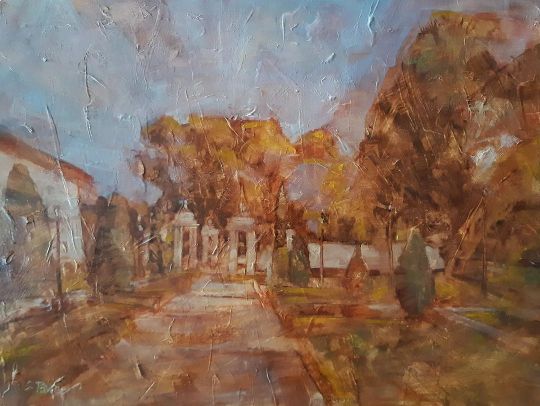
“Nei Giardini all’Italiana a Cernusco", olio su legno, cm. 40 x 53 x 1,5, verniciato, firmato, con timbro e certificato d’autenticità sul retro È questa indubbiamente un’opera particolare! “Nei Giardini all’Italiana a Cernusco” è un olio su tavola dipinto en plein air, in inverno, nei famosi Giardini all’Italiana di Cernusco sul Naviglio. Il pittore Claudio Pavone è da sempre affascinato da questo luogo storico della sua città. E cerca di trasmetterne l’emozione e la magia. Su questa tavola, infatti, vediamo tutto ciò, fissato con colori forse insoliti, dalle sfumature evanescenti che interpretano in libertà le geometrie di questo posto diventato sì, per i cernuschesi luogo di passeggio e di svago, ma anche e soprattutto luogo di passaggio nei giorni feriali. Fissandovi lo sguardo, si rivive un momento di estasi di fronte all’incanto di quel frammento ordinato di natura che l’artista volle condividere col proprio pubblico. (presso Cernusco sul Naviglio) https://www.instagram.com/p/CktaqFrLHw7/?igshid=NGJjMDIxMWI=
0 notes
Text
DIA 6 DE NOVEMBRO DE 2022: RITUAL DO DOMINGO LISBOETA CUMPRIDO . IDA AO TEATRO AZUL EM ALMADA PARA “ O MEDO DEVORA A ALMA “ DE FASSBINDER . UM BOM ESPECTÁCULO ; A EXPOSIÇÃO CHRONOS DE FDE CLAUDIO FERREIRA . GUIAR A NOITE É AGORA UM PESADELO : depois de cumprido o ritual dos domingos na Versailles o dia incluía uma ida a Almada . Depois de almoçar no restaurante do Teatro Azul assistimos a versão encenada por Rogério de Carvalho do filme “ O medo devora a alma” de Rainer Werner Fassbinder (1974).O contacto com o cinema de Doiglas Sirk é determinante na carreira do alemão que, procura criar filmes “como os de Hollywood, porém sem a hipocrisia”. Essa influência é particularmente visível neste O medo come a alma, um filme de 1974 que é decalcado de All That Heaven Allows (O que o céu permite), de Sirk (1955).No filme americano, a actriz Jane Wyman é uma viúva rica que se apaixona pelo seu jardineiro, interpretado por Rock Hudson. Fassbinder transporta a acção para a Alemanha da década de 70, extremando as diferenças de idade, de cultura e até raciais. Na sua versão, temos Emmi, uma viúva sexagenária que trabalha como mulher-a-dias, e Ali, um imigrante marroquino, que trabalha numa oficina de carros e é muito mais novo do que ela. Contra todas as probabilidades, Emmi e Ali encontram um no outro a fuga às suas solidões. Só que ela vai começar a sentir a discriminação por parte de quem a rodeia – vizinhos, colegas e os próprios filhos –, para quem o relacionamento com um estrangeiro “escuro” é um escândalo. O par decide casar-se mas a relação ressente-se do ambiente de intolerância em que vivem. Retrato de uma Alemanha em crise, esta continua a ser, apesar de tudo, uma história de amor –. Foi um bom espectáculo ! Meticulosa encenação de Rogerio Carvalho, J.M. Castanheira assina uma cenografia interessante bom desempenho dos actores ,com destaque para os protagonistas principais mas sobretudo para Teresa Gafeira . Cena final marcante . Como sempre o livro dos textos de Almada valioso . Houve também tempo para ver na Galeria de Exposições Chronos as curiosas fotografias em que Claudio Ferreira concentra todo um espetáculo numa única película com exposição de 45 minutos . O pior foi o regresso já noite cerrada neste horário de inverno . Para mim guiar a noite hoje em dia e um pesadelo
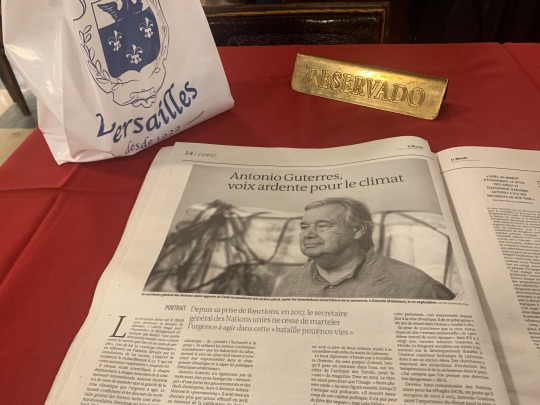
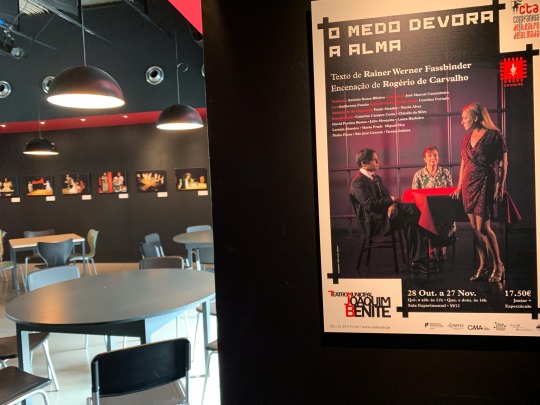

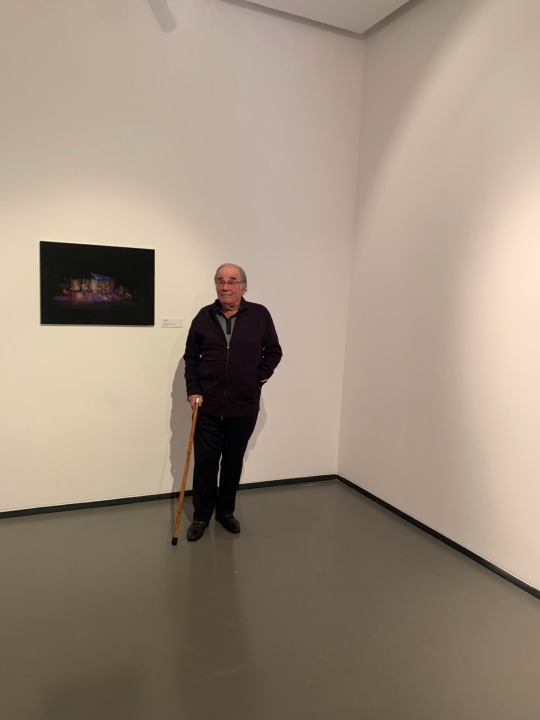
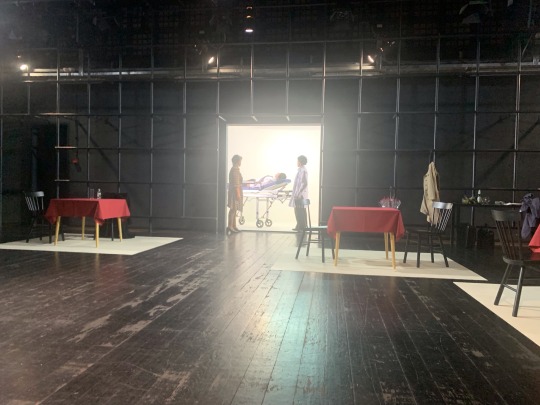

0 notes
Text
Adaptado e dirigido por Pitty Webo,
espetáculo fará única apresentação no Teatro J. Safra.
Dia 25 de setembro, às 11h30.
O espetáculo “Os Três Porquinhos”, propõe um divertido jogo lúdico, com comédia e aventura, abordando temas como solidariedade, medo e compaixão entre irmãos. A história acontece numa noite muito movimentada na floresta. Adaptado e dirigido por Pitty Webo, a montagem fará única apresentação no Teatro J Safra no dia 25 de setembro às 11h30.
O porquinho Puffy é estudioso, seu irmão Poffy é guloso e preguiçoso, e a porquinha Piffy é medrosa. Mesmo com tantas diferenças, eles precisam se unir porque o inverno está chegando e com ele a ameaça de um faminto lobo, que logo se mostra divertido e atrapalhado. O lobo se julga um ótimo ator, mas na realidade é um canastrão com figurinos de época, fazendo referências ao personagem Hamlet, de Shakespeare.
A montagem busca a identificação do público infantil com as personagens. Por isso os porquinhos brincam muito. Puffy, Poffy e Piffy brincam com a língua inglesa, fazem desafios de tabuada e conversam sobre astronomia. “A ideia é fazer com que as crianças se identifiquem com matérias escolares. Os porquinhos desta montagem gostam de ler, de questionar tabuada, de saber os nomes dos animais, estudar o sistema solar e a língua inglesa.
“Usamos matérias do primário e as colocamos em cena como brincadeiras divertidas”, diz a diretora Pitty Webo, que sempre estimula a interatividade com a plateia em suas peças para crianças.
O lobo inventa disfarces e julga dominar poderosas técnicas de convencimento para atrair os porquinhos. Enquanto ele não aparece, Puffy, Poffy e Piffy exploram a sua capacidade de comunicação corporal em mímicas. A encenação valoriza a construção física das personagens, busca um jogo ágil entre os atores, que brincam com instrumentos musicais e cantam em gromelô cantigas, como, “Marcha Soldado”, “Ciranda Cirandinha” e “Hava Nagila”.
Pitty Webo observa que, ao mesmo tempo em que cria situações novas para as personagens, aborda a história clássica sem enfatizar o medo e a violência presentes em tantos contos. “Nas minhas adaptações os personagens resolvem o seu próprio conflito e vencem seu medo. E através da comédia, desconstruirmos os vilões, justificando também seus objetivos”, diz.
SINOPSE:
Os porquinhos Puffy, Poffy e Piffy vivem numa floresta. Puffy é estudioso, Poffy é guloso e preguiçoso, Piffy é medrosa. Eles precisam se unir porque o inverno está chegando e com ele a ameaça de um faminto lobo, que logo se mostra divertido e atrapalhado. A criançada se diverte com essa aventura, que aborda temas como solidariedade, medo e determinação.
SERVIÇO
“Os Três Porquinhos”
Texto e direção: Pitty Webo
Elenco (em ordem alfabética): Claudio Marinho, Felipe Rua, Pitty Webo e Victor Di Lourenço.
Gênero: Infantil
Duração: 40 min
Classificação: 2 anos
Data e horário: dia 25 de setembro, às 11h30
INGRESSOS: de R5 5 a R$ 10 reais
Crianças a partir de 2 anos pagam meia entrada em qualquer setor.
Crianças de 1 ano e 11 meses ou menos não pagam (ficando no colo do responsável) mediante a apresentação de documento comprovando a idade.
Ingressos online: https://www.teatrojsafra.com.br
Bilheteria
Quartas e quintas – 14 às 21h
Sextas, Sábados e Domingos – 14h até o horário dos espetáculos
Vendas online:
Aceita os cartões de débito e crédito: Amex, Dinners, Elo, Mastercard, Visa e Hipercard. Não aceita cheques.
Telefone da bilheteria: (11) 3611-3042 (011) 3611 2561
TEATRO J. SAFRA
Endereço: Rua Josef Kryss, 318 - Barra Funda - São Paulo – SP
Telefone: (11) 3611-3042
Abertura da casa: 2 horas antes de cada horário de espetáculo, com serviço de lounge-bar no saguão do Teatro.
Capacidade da casa: 627 lugares
Acessibilidade para deficiente físico
Estacionamento:
Valet Service (Estacionamento próprio do Teatro) - R$ 30
FICHA TÉCNICA – ”Os Três Porquinhos”
Texto e direção: Pitty Webo
Elenco (em ordem alfabética): Claudio Marinho, Felipe Rua, Pitty Webo e Victor Di Lourenço.
Desenho de figurino e caracterização: Pitty Webo
Costureira e modelista: Joana Sales
Assistente de figurinos: Lulu
Desenho de cenário: Pitty Webo
Marceneiro: Reinaldo Lopes
Montagem de cenário: Rodrigo Pereira
Trilha sonora: Pitty Webo
Arranjos: Victor Di Lourenço
Preparação corporal: Pitty Webo
Desenho de luz: Pitty Webo
Ilustração: Marilena Saito
Crédito do fotógrafo: Jeronimo Gomes
Transportador oficial: ML Entregas Urgentes
Administração e promoções: Gabriele Oliveira
Produção Executiva e Marketing cultural: Caroline Santana
Realização: Companhia Pitty Webo Arte & Cultura Ltda.
0 notes
Text
Il Peperoncino Jazz Festival prosegue sulla costa tirrenica

Il Peperoncino Jazz Festival prosegue sulla costa tirrenica
In occasione della XXI edizione il Peperoncino Jazz Festival dopo alcuni anni è tornato a far tappa nell’accogliente centro storico di Montalto Uffugo e lo ha fatto con un’interessantissima “tre giorni” di jazz internazionale ad ingresso libero fortemente voluta dall’assessore alla Cultura Gianfranco Bria e da tutta l’amministrazione comunale guidata dal sindaco Pietro Caracciolo.
Nei primi giorni del mese a salire sul palco sono stati due incredibili artisti americani: lo storico batterista del Pat Metheney Group, Paul Wertico (che in compagnia del notevole contrabbassista Gianmarco Scaglia e dell’eclettico pianista Fabrizio Mocata nella graziosa piazzetta Rizzo ha dato vita ad una serata ricca di suggestioni contemporanee e sonorità moderne, spaziando da composizioni originali all’esecuzione di brani improvvisati sul momento) e il carismatico Eric Daniel, sassofonista dalle mille collaborazioni importanti (tra cui ricordiamo quelle con Zucchero, Natalie Cole, Alex Britti, Andrea Bocelli, Joe Cocker, Gino Paoli, Antonello Venditti, Tom Jones, Amii Stewart, George Benson. E, ancora, Paul Young, Randy Crawford, Jerry Lewis, Stevie Wonder, Ella Fitzgerald, Gil Evans, Eduardo De Crescenzo, Toots Thielemans, Mike e Randy Brecker), che dialogando musicalmente con l’affiatato duo “In Milonga” (composto dal chitarrista Sasà Calabrese e dal fisarmonicista Salvatore Cauteruccio) è stato protagonista di una serata all’insegna del fascino e della sensualità del tango argentino e delle altre musiche caratteristiche del Sud del mondo nello splendido chiostro di San Domenico.
Dopo queste prime due riuscitissime tappe, nel corso delle quali un pubblico numeroso e attento ha apprezzato moltissimo il ritorno in città dell’evento a cura dell’associazione Picanto diretto da Sergio Gimigliano, il 21 agosto il festival musicale più piccante d’Italia è tornato a far tappa nel bel chiostro di San Domenico con un terzo concerto, anch’esso a ingresso libero e di rilievo internazionale (patrocinato dalla Fondazione per la Cultura svizzera Pro Helvetia), che ha visto di scena il duo svizzero composto dalla cantante Yumi Ito e dal chitarrista Szymon Mika.
Molto affini musicalmente e spiritualmente e soliti mettere in piedi live caratterizzati da una esibizione fortemente sinergica, Yumi e Ito per l’occasione hanno presentato al pubblico il loro nuovo album “Ekual”, proponendo in scaletta brani come “Minha Flor”, “Data” e “Float and Drift”, che evocano la dolce pioggia su una foresta primaverile dove la vita inizia a sbocciare dopo un rigido inverno.
I due giovani e talentuosissimi musicisti, già molto apprezzati non solo nella loro patria ma in tutta Europa, attingendo dalla versatilità della voce e degli archi, hanno regalato il loro universo di armonie gentili, accordi ossessionanti, melodie intricate e improvvisazioni esplorative anche al pubblico che il 22 agosto è accorso nello splendido Castello di Sangineto per una serata patrocinata dall’amministrazione guidata da Michele Guardia e fortemente voluta dal consigliere Francesco Terranova.
Martedì 23 agosto, poi, l’itinerario musicale (ma anche turistico e culturale) del PJF continuerà ancora sul Tirreno cosentino con una doppia tappa in programma a Belvedere (dove il festival ritorna dopo un’assenza di anni grazie a Raffaela Sansoni, nuova assessora alla Cultura della neo insediata giunta guidata dal sindaco Vincenzo Cascini), con il concerto del fantastico duo composto dalla raffinata cantante Mafalda Minozzi e dal chitarrista americano Paul Ricci in programma alle ore 22 presso il Belvedere di Capo Tirone e a San Nicola Arcella (località nella quale il PJF fa tappa da anni, gli ultimi dei quali grazie alla bella joint-venture con “Un tuffo nel Blues”, evento in memoria di Claudio Tommasini), che nello storico Clubbino (locale che da oltre 30 anni rappresenta un indiscusso punto di riferimento per tutta la costa tirrenica) vedrà di scena, alle ore 23 gli esplosivi Groovin’ High.
Il 24 agosto, il PJF dopo alcuni anni di assenza farà una tappa ad Amantea grazie alla collaborazione con un altro importantissimo festival calabrese: La Guarimba Film Festival; per l’occasione, presso Il Terrenito guarimbero, spazio multidisciplinare costruito dagli organizzatori del festival amanteano proprio con l’obiettivo di fare aggregazione, alle ore 22 si esibiranno i Calabrian Jazz Experience.
Prima dell’ultima tappa tirrenica (il concerto del portentoso pianista americano David Kikoski realizzato in joint-venture con “Un tuffo nel Blues”) in programma il 29 agosto alle 22 nello splendido belvedere di San Nicola Arcella, dal 25 al 27 agosto ritornerà la “tre giorni” patrocinata dal Comune di Scalea (fortemente voluta dal presidente del consiglio comunale Gaetano Bruno, dal vicesindaco Annalisa Alfano, dall’assessore al Turismo e Cultura Adelina Carrozzini e da tutta la compagine amministrativa guidata da Giacomo Perrotta) all’insegna del “Laos Jazz Fest”, che nelle tre serate alle ore 22 nel suggestivo scenario del giardino di Palazzo Spinelli vedrà di scena, rispettivamente, la poliedrica cantante Ada Montellanico, il talentuoso crooner Walter Ricci e il coinvolgente Terjie Nordgarden, cantautore norvegese che si esibirà praticamente in contemporanea con i sorprendenti AmaJi, che saranno protagonisti nel centro storico di Paola grazie alla collaborazione con il Margini Festival.
CONSULTA IL PROGRAMMA COMPLETO
...
Read the full article
0 notes
Photo


Mi sarebbe piaciuto raccontarti delle storie, a letto o sulla spiaggia a correggere mille errori sulla sabbia. Mi sarebbe venuta voglia di tenerti la mano sotto le lenzuola quando per sbaglio aprivi gli occhi e mi trovavi lì che già ti guardavo da un pezzo. Mi sarebbe bastato un bacio per andare a dormire come se là fuori il mondo intero non ci urlasse contro, che a fare a gara con il tempo si arriva sempre per ultimi e finisce che perdi tutto. Mi sarebbe venuta voglia di spogliarci lasciando cadere a terra la nostra pelle lasciando le ossa scoperte, di star seduti sotto la pioggia e poi cercare una coperta e avere una scusa in più per stringerti. Mi sarebbe andata bene averti di nuovo, averti ancora come forse non ho più avuto l'occasione.
4 notes
·
View notes
Text
Jane Eyre (1996): Under the Tender Tuscan Sun
(1983)

You either die a hero, or live long enough to see yourself become the villain
Anyone that knows me knows that when it comes to adaptations of my favorite stories, I'm rather fastidious re: accuracy, specially regarding themes, structure and characterization. I used to think of myself as someone that would never --the horror-- belong to the camp of those who love movies like Mansfield Park (1999) or Pride & Prejudice (2005); and even though I grew and matured and learned to appreciate what of good they have to offer, I said I'd never truly love a movie like that. Clown shoes noises.
The 1996 movie titled Charlotte Brontë's Jane Eyre, directed by Franco Zeffirelli is, ironically, the less Brontë of all the adaptations of this novel I have watched. It is very much Franco Zeffirelli's Jane Eyre, and in that way it is a close relative of MP99 and P&P05; if MP99 is the portrait of how Patricia Rozema would write Austen's characters, and P&P05 is Austen's story through the emotional magic realism of Joe Wright's lens, JE96 is very much Zeffirelli taking this story and these characters and repainting them under the tender Sun of his Tuscan homeland.
And the thing is, I loved this movie. It touched me and it stayed with me after I watched it; it resonated with things I had in my heart. Below the cut, the good, the bad, and the interesting of Jane Eyre (1996).
The technical aspects
If anything, this is a very pretty movie to look at: the composition of shots and the sets are very nice; the costumes, while not particularly eye-catching, are very elegant and evocative of the 1840s lines. One shocking thing is how well lit this is. Had I not lived through the dark age of cinema around 2010, where it was impossible to see anything happening on the screen, I would complain about it, but, honestly, I want to actually see things in a movie, I don't care if the Moon looks more like a giant spotlight than a natural satelite. Besides, for a moody, gloomy, realistically lit Jane Eyre, we now have 2011!
I cannot say, for obvious reasons, what the color balance of the movie was when it was in cinemas, but it seems to me that the more recent the rendering, the more blue/magenta it is, which clashes with the warmer general tone of the adaptation. Compare footage from this, this, this, and this trailer with the screengrabs from the bluray below:

Besides making Rochester look like he's about to die from asphyxia, it gives interior shots a "fluorescent overhead lights" vibe that is not good.
On the other hand, the pacing of the movie is... irregular. The two first thirds of the movie go at a good pace in film terms, but then it takes a high speed train to the ending that may leave more than one dizzy.
The music for this production is distinctive and gorgeous; it's very simply structured around three main motifs: a journey motif (very clear in Infanzia di Jane, Viaggio di Jane), a love motif with a joyful (Tema di Helen, Matrimonio di Jane) and a wistful movement (Tema di Jane, Jane e Rochester), and a dark motif with a regret (Tema di Rochester, Ritorno a Thornfield) and a danger (Incendio a Thornfield, Inverno a Lowood) movement. The score moves seamlessly from poignant and reflective to sinister to hopeful, to innocent and pastoral and back again.
Locations
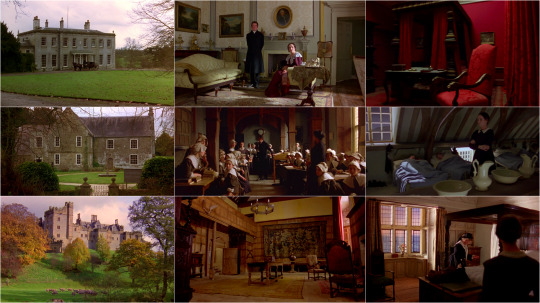
From top to bottom: Gateshead, Lowood, Thornfield.
Gateshead is a modern house, filled with comforts and luxuries, but ultimately cold. Lowood, in turn, presents a mixture of the coldness of its blue and green walls with warm wood beams and furniture: Lowood is both Mr. Brockelhurst and Miss Scatcherd but also Miss Temple and Helen Burns.
This was the first time Haddon Hall was used as a stand in for Thornfield (that I know of), location repeated in 2006 and 2011, and the portrayal of this house is one of the most interesting things to compare between adaptations. In this one, it is made old but approachable under the sunlight (we get to see geese and sheep around! Idillic!) and its generous garden; shady and bleak in its courtyard, upper galleries and library, warm and welcoming at its heart (drawing room, Mrs. Fairfax's parlor, Jane's room): a reflection of its master.
Jane at Gateshead
Fiona Shaw plays a perfectly nasty aunt Reed, and her children, while very little onscreen, do match her intensity (this is the moment you realize Fiona Shaw also played Aunt Petunia, and suddenly Harry Potter = Jane Eyre+LotR, but I digress). Mr. Brockelhurst is also properly cold and overzealous; but Anna Paquin as little Jane steals the screen. She's every bit the fiery creature with a strange, uncanny gaze that people like the Reeds would bully and mistreat.
This section is very short: we are shown Jane's mistreatment, given some exposition about her origin and family situation, and then she's promtly shipped off to Lowood, where the narrative will stay for almost twenty minutes.
Lowood: punishment and mercy
In the novel, three teachers stand out: Miss Temple, the kind headmistress; Miss Scatcherd, the choleric and arbitrary teacher; and madmoiselle Pierrot, the French teacher. While the latter is nowhere to be seen in Zeffirelli's version, the other two have switched places: Lowood is ruled with an iron fist by Brockelhurst and Scatcherd, while Miss Temple, from her subordinate position, feels for the girls and comforts them with words of kindness and encouragement.
In the novel, Miss Temple is an aspirational authority figure; in this movie she is first and foremost a warm motherly figure. In this tune is also that, I think, should be understood that Jane leaves Lowood and Miss Temple stays: Jane, Rochester and Adele have been left behind by their mothers, either by death or by choice. Miss Temple is the mother that stays and sees as the mission of her life to bring a ray of sunshine to the lives of the really or virtually orphaned girls of Lowood.
Miss Temple is not the only kind figure at Lowood: there's also Helen Burns.

While Brockelhurst embodies a punishing piety, Helen Burns embodies a merciful piety. In the book, this is shown through her strong belief in God as a caring father and her advice focused on Jane's happiness. In this movie, Helen's faith moves her to action: not only does she invite Jane to warm up in her bed and comforts her about her own passing -like in the book- but seeks out her company when she's new and mischaracterized as a liar, feeds her when she's hungry, and helps other girls get ready in the morning.
Helen's death scene is one of the most emotional points of the movie, and one that never fails to make me tear eyed.
By the end of Jane's time at Lowood, discipline has made her austere, but the affection of Helen and Miss Temple has imbued her passionate spirit with tenderness, and that's what she carries with her into her new life.
The Housekeeper of Thornfield Hall
Mrs Fairfax, with her air of Italian grandma is surprisingly close to her book counterpart in manners, heart and behavior, but unlike in the book, it's clear that she is in the know of everything. She is as much a keeper of Rochester's secrets as she is of his house. When Bertha's brother arrives and introduces himself as Mason from Jamaica, Mrs. Fairfax looks shaken: she knows exactly who he is.
This puts her character in a very conflicted position; it is clear that she cares a lot for both Rochester and Jane, she knows that they are well suited, but also that the attempted marriage will bring disaster, sooner or later.
Jane and Adele
Keeping with the theme of childhood, Adele is not just an excuse for Jane to be there, but a real character within the narrative. She is spoiled and not very bright, though very affectionate at heart, just like in the book, but stripped from coquetish and sensual aspects that Charlotte gives her.
"Will we be very happy?" Adele asks Jane when they first meet, and Jane replies "we shall work hard and be shall be content." We get to see Jane teach Math, piano, and drawing to Adele, with firmness, but at the same time indulging her just desires and petitions.

Rochester's rejection of Adele awakens Jane's passions as it reminds her of the rejection of those who should have loved her as a child; the Ingram party abusing governesses distresses Adele, who was until then so enthusiastic about seeing the beautiful ladies. During Jane's absence, the portrait she made of Rochester at Adele's request, to remember him by in case he left, becomes an element of connection by which the latter two remember her and grow closer to each other, signaling that Jane has brought a ray of tenderness to both their solitary lives.
Other side characters
John, Leah, Blanche, Mary Rivers are all well played in their small roles. Richard Mason is most likely too old for the part. St. John Rivers is cold and stiff and slightly sinister, but has ridiculously little screentime in this movie. Grace Poole is an alcoholic shell of a person, reflection of the thankless job she performs as a nurse.
The Shadows are as Important as the Light
Let's address the elephant in the room: William Hurt's Rochester and Charlotte Gainsbourg's Jane.
It certainly is true that Charlotte lacks the otherwordly air of Anna Paquin, but honestly... how common is that? I do think the character transition makes sense, as I have explained above, and though a softer transition would have been more welcome, the reality of cinema is that every second matters and sometimes important things are sacrificed.
Gainsbourg Jane is not naturally sweet or severe, and not only does she have true outbursts here and there (she even manages to retorically ask Rochester "How can you be so stupid?" which is... too much even XD), she also loves with all her heart. While the severity of Lowood has repressed her, the learned kindness has given her love the restraint that prevents from destroying or hurting the object of love: tenderness.
It has also given a similar kind of moderation to her sense of justice: instead of hitting back those who hit you, Jane is lead to stand by Helen's side when her hair is cut, which is both protest and solidarity with her friend. A similar theme follows her forgiveness of Mrs. Reed (though this one goes more on the lines of the set up and payoff of the original novel).
This is the core argument of Zeffirelli's take on the story: Brontë's novel is constantly contrasting ambition and passion, love and duty, fire and snow, head and heart. The idea that you need both, that the choice doesn't really have to be either Rochester or St. John is not particularly original (it is Aristotle's very notion of virtue as the golden mean) and neither is the idea that eros, the burning and possesive love, will consume and destroy the object of love if not balanced (That's Plato); the interesting part is how this message is woven within the story.
I understand why this choice is not very liked; it is a departure from some of the main notions and themes of the original story; it also diminishes greatly the pathos and catharsis of it, which is one of its main draws for the reader. I do love it, because I have always loved this kind of dynamic, but in this way I fully understand why others don't, and I think it is an extremely fair position, specially because in the way it is commentary, it is also betrayal of the source material.
The Orphan Master
Our first introduction to Rochester in this movie is by a contrast between his father's portrait --big, cold, against a classic black backdrop-- and his own: a young child with a clear landscape behind. Mrs. Fairfax's description calls the way Rochester was treated by his family "barbarous" and tells us he is not a happy man. Jane studies his portrait and smiles.

This introduction aligns Rochester with Jane and Adele: he was virtually an orphan, but unlike them, he had no Miss Temple, no Helen, no Jane growing up. Zeffirelli's Rochester is a man made old by lack of affection and restless wandering; a contrast with the novel, but not something you could call unrealistic: I'm 27 and find tiredness with life very relatable. He is also filled with self loathing: when he sees the portrait Jane has made of him, he says "you have me utterly" and crumples it. Only after she makes her comment about the shadows being as important as the light he recovers some of his humor. In keep with the theme of tenderness, Rochester is made far more polite and gentleman-like than his book counterpart. What I'm trying to say is that rather than being an unintended mistake, it is a deliberate choice, from script to direction, which also aims at making more consistent the latter part of the story.
That said, William Hurt's portrayal of this characterization is... mixed to say the least. In some scenes he delivers well (their first meeting, their second conversation, the one after the fire, the ending scene) and others it comes across as wooden or undecided (Jane's return from Gateshead, the first half of the proposal, or the painful "DON'T LEAVE ME, JANE").
Jane and Rochester
So, how do these characterizations work in their dynamic? Even though unlike 1983 there is a sense that the actors are playing off of each other and building a rapport, it is focused on a sense of mutual recognition and unlearning toxic traits and behaviors, whereas in the book it's their intellectual sparring and easy chemistry that makes the deal.
Even though it lacks the nocturnal surrounding of the novel, their first meeting is very, very close to the book: Jane reaches the road, hears the horse, sees the dog, they pass her and only then the horse falls (in this case, though, rather than a sheet of ice, it seems the cause is Rochester's double take on her, which I find funny); at first Rochester ignores Jane, and then rejects her help, but his interest is piqued when she insists (in the novel this is more about Jane being bored, while here it is squarely an act of kindness); he is distracted by her answers and then amused at her attempts at grabbing his horse (fun fact: this is the only adaptation I have seen that keeps this from the book: "The traveller waited and watched for some time, and at last he laughed."); the meeting ends with a flirtatious advice to get home fast. This scene encapsulates the whole development of the romance on Rochester's side.
Their following conversations leading to the night of the fire have Rochester trying (and succeeding) to draw Jane out, while she is more and more attracted to his "shadows and light"; this section is the best part of their interactions in this movie.
In my review of 1983 I mentioned the "that stings your pride" line, as representative of the disconnection between that Rochester and that Jane. Here it is used very well to show us an understanding: Rochester praises Jane first, then asks "perhaps some master helped you?" this touches a tender spot on Jane, who stands up to answer almost indignantly "nobody helped me, sir." "Ah! that wounds your pride". Both Jane and the audience realize Rochester's intention here. He praises her again, there are some smiles, and Rochester rapidly changes to a more formal tone and dismisses her.
In the following scene, outdoors, Jane knows the tone of his "Do you find me handsome, miss Eyre?" question and gives her answer in the same playful tone. The scene also includes the "heart full of tender feelings" and "india rubber-flesh" lines, and adds a new element: Jane draws Rochester's portrait at Adele's request. This way we get to see Rochester through Jane's eyes.
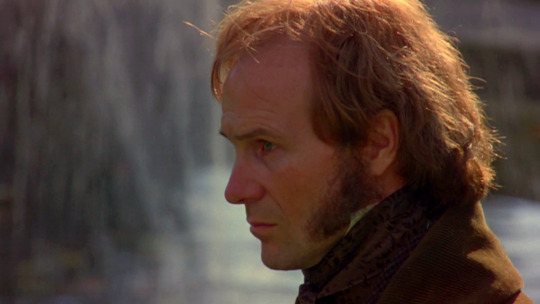
Compare with Helen Burns' portrait scene, the only other portrait Jane draws in this movie. Same sunlight lights them up from behind as objects of love they both are; but unlike Helen, we only see half of Rochester's face. There's a side of him that remains hidden.
Then the fabricated "the shadows are as important as the light" line follows, and Rochester calls Jane to walk with him through a gallery, from light to shadow and back to light again; things will get worse before they get better.
The night of the fire, Rochester and Jane have a discussion: Adele dances for them, we see Rochester watching her from a corner like a chastised child. He sends her to bed, Jane overreacts and he angrily tells her the story of Celine. The shared experience of being unloved is the trigger here, and the exchange of kindness is the opposite trigger of their sudden intimacy in the following scene where Jane saves Rochester from the fire.
The symbolism added to the fire scene is that of the roses; in order to save Rochester, Jane has to throw away the roses (symbol of love) to put out the fire, and she gets hurt in the process (the roses had thorns). The tender feelings of Rochester are manifested in his tending to Jane's wounds (not that much india rubber after all).
This is the midpoint of the story, and from here onwards the movie gets progressively... not as good.
The Blanche Ingram plot is set up, Rochester, consistently kinder than his book counterpart, cuts himself the badmouthing of governesses, we see Jane suffering and her helping with Mason, but Rochester and Jane's conversation about Blanche is omitted. Clearly Zeffirelli has no idea what to do with this part of the plot, and the disinterest shows, except for a few nice touches here and there (a mirror scene I'll talk about later, Adele's distress about the situation, the symbolic representation of Jane's high moral ground and Rochester's tenderness). Rochester's intentions on sending Adele back to France are unclear, as is his playing with Jane's jealousy and his feelings upon her return.
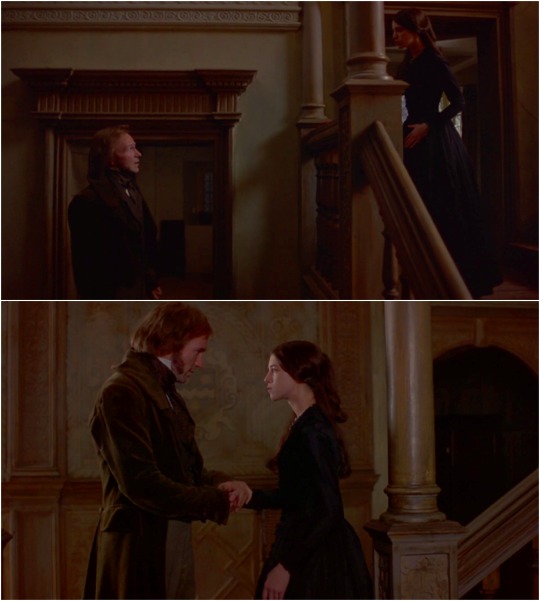
What is clear is that Rochester fears Jane may not return; the orphan abandonment issues are highlighted, as is his loneliness in Jane's absence.
As I mentioned above, the return to Gateshead scene is very good.
The proposal scene is very good on a cinematic level, IMO, but very weak at the script level. As the Blanche tension has not being raised, the payoff here falls flat. The dialogue is deprived from some of its most iconic lines (it's my spirit that addresses your spirit, I'd make it as hard for you to leave me, etc), but Zeffirelli makes a beautiful use of the garden imagery and its biblical allusions (Genesis and Song of Songs; temptation and sensuality) from the book, and as the scene progresses Jane gets more "trapped" between Rochester and the greenery. The omens, like many other gothic elements of the story, is omitted.
We get Mrs. Fairfax's knowing warning, Jane's foreboding about the wedding is missing, and the morning of the wedding is a happy one, to the more contrasting effect with the failed nuptials. The latter is dramatic enough (the COME AND MEET GRACE POOLE'S PATIENT, MY WIFE needs to be there and needs to be dramatic, for me), Rochester is properly angry, Jane properly shocked and wounded. I'll talk about the Bertha scene later.
The taking leave scene is extremely short; against Rochester's confidence in the book, but in keeping with the abandonment theme, a scared Rochester says "I love you, say you love me". Jane has closed upon herself again, and gives a dignified answer "I love you more than ever, but this is the last time I shall ever say it. I must leave you." Rochester chases after her begging her not to leave him.
And here comes what I think is the biggest change/betrayal/commentary: Bertha takes the opportunity of the distraction to burn Jane's wedding dress and bed. In the midst of his chase, Rochester is called by some farmers that point him to the hall on fire. Rochester hesitates, but upon seeing Bertha on the roof, chooses to return and save her life. For Rochester to find redemption in the novel, he needs to have his hand and eye cut off in order for him to turn to God; in this version the failure of the wedding and Jane's departure are the moment of grace that allows him to do the right choice and perform a last act of tenderness and proof of his character: he honors his duties, no matter how they were contracted. Even after Bertha accidentally kills Grace, he still coaxes her gently to come with him, showing once more that he doesn't blame her for her illness. Bertha refuses him and jumps to her death; the stairs give in and Rochester falls as well screaming Jane's name.
Portraits and mirrors
Unlike other weaker symbolisms used in this movie (the ambiguous chess set that hints both Rochester's games and his loneliness but that becomes ridiculous when a blind Rochester has a board by his chair), portraits are consistently used to reveal character and signify affection (Jane's drawing of Helen and Rochester's, young!Rochester vs. old Rochester, and the ones of his uncle and father Jane receives as heirlooms) and mirrors to signify fear and anxiety.
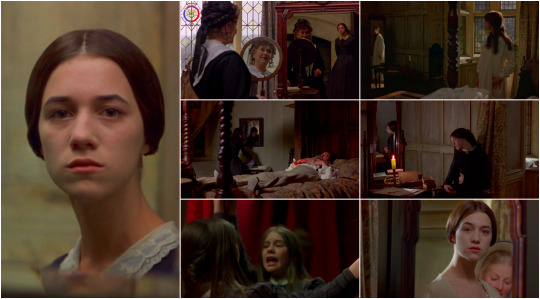
From left to right and top to bottom: Jane stares at her image after learning of Blanche's existence; Mrs. Fairfax tells Rochester's backstory before Jane hears Bertha for the first time; Jane sees herself in the mirror as Bertha puts fire to Rochester's bed; Bertha attacks Mason; young Jane in the red room; Jane on her wedding day, only hint at her wedding anxieties in this adaptation.
Bertha is the other woman, the woman in the mirror, reflection of Jane's fears. When they finally meet we are struck by their resemblance: white skin, black hair, dressed in white. They recognize each other as women and as the other woman. This humanizes Bertha while still attempting to keep the danger factor of her presence as well. Like other adaptations, Bertha attacks Jane, her image, rather than Rochester, as in the book.
Jane and the Rivers
Because of Zeffirelli's focus on the theme of tenderness, St. John's character loses all sense of meaning and becomes a non entity. Consequently, Jane's time with the Rivers is breezed over in a painfully clumsy and awkward way. We first meet St. John as Gateshead's parson, and to the parsonage is that Jane turns in her flight. She inherits John Eyre's fortune (the one remarkable point here is the heirloom of the portraits), politely refuses St. John's proposal, while still providing for his missionary work and giving away some money for the girls at Lowood, that St. John will administer in her name.
Jane cannot forget, and so she goes to visit Helen Burns' grave, perhaps in a search for answers. She hears Rochester's call in the wind, and after St. John's proposal, self reflection leads her to take this as a sign to return to Thornfield; in both the Spanish and the Italian dubbing, words of Rochester from the proposal and the take-leaving scenes are heard, as Jane gazes through a window: "Jane... you strange, almost unearthly thing, I love you like my own flesh... I love you, say you love me... Jane... Jane...". this was, perhaps, considered too sappy for the English version, but it makes that subtext explicit.
Jane and Rochester reunited
So, if the second half of the movie was mostly unfocused and clumsy with little gems here and there, the ending I love to bits.
Jane finds a resigned and sad Rochester, sitting in what looks like the old stables of the house. It's a sunny, calm morning and the sun shines through arched windows. Rochester pleads with the vision of Jane not to leave him, in a sweet rather than desperate way. If before he towered over here, now she's the one to gaze down on him and kiss his forehead tenderly. If his physicality was guarded and distant before, now he receives her with arms and legs open. She kneels down to talk to him at his face level, even if he cannot see her. They are now equals. He raises to give the "I'm like an old chestnut tree" (a pity that the chestnut tree was not featured in the proposal) speech, and as she replies, she wraps her arms around him like the vines in the metaphor.

The very end closes with Jane's narration about their future, including a note about their adopting Adele and bringing her to live with them as a family.
Summary
Franco Zeffirelli takes Brontë's gothic story and makes a commentary movie, sunny, warm, tender, focused on the traumas of childhood and the way in which big and small acts of kindness bring healing. It is a light movie for people that vibe with that, either a snore fest or an absurd betrayal for those that cherish the pathos and conflict of the novel. The theme of tenderness gives us a restrained Jane and Rochester, while the latter is also kinder and more despondent than his book counterpart, yet still keeping elements of his gruffness and narcissistic insecurity.
Production values are excelent, and acting goes from inspired to mixed, being the latter part of the script the biggest weakness of the movie, and it's choice of themes and commentary, the most controversial.
#Jane Eyre#Jane Eyre 1996#Franco Zeffirelli#jane eyre review#Charlotte Brontë#period drama#it is finished and I am exhausted#Spotify
23 notes
·
View notes
Text
tw: morte, lutto
Quando mi sono trasferita nella mia casa la prima cosa che ho portato è stata la foto di me e Claudio a Barcellona nel 2012.
Lui era morto da una manciata di mesi e io avevo già vissuto metà inverno, una primavera e un’estate senza di lui. Erano già accadute tante cose: quella stessa estate lasciai G. e mi sentii libera da un immenso peso. Qualche settimana più tardi conobbi M., l’angelo disgraziato destinato a proteggermi.
La prima sera nella mia casa non avevo nulla. Il divano era dei vecchi inquilini, ed era stravecchio.
Lercio, ingiallito, a tratti maleodorante. Non riuscivo a non pensare a quante scoregge ci avessero tirato sopra quegli stronzi dei vecchi inquilini, che mi avevano lasciato solo quel cazzo di divano prescoreggiato, tra l’altro manco per farmi un regalo di benvenuto, quasi sicuramente perché si scocciavano di chiamare il servizio di smaltimento dei divani vecchi e puzzolenti.
La mia terapista me lo ha fatto intendere sottilmente: la mia totale assenza di emozioni a eccezione del sorriso perennemente stampato sulla faccia ad arredare il mio volto durante le nostre sedute è una roba da psicopatici, o qualcosa del genere, quindi si è sentita quasi sollevata quando ha visto le lacrime rigarmi le guance durante il nostro ultimo incontro, quando ormai non riuscivo a organizzare più nemmeno i miei pensieri.
Le ho detto che non sorridere mi sembrava un atteggiamento ingrato. Che dovrei farlo davvero, magari, solo che proprio non riuscivo a sentire quella felicità e quella spensieratezza che avrei dovuto sentire. Claudio è morto.
Ogni tanto stacco la nostra foto dalla cornice e leggo cosa mi aveva scritto dietro.
Immagino che un giorno nella tua nuova casa aprirai uno scatolone e troverai questa foto un po’ impolverata e malconcia… ma è solo una foto, la nostra amicizia rimarrà intatta e pulita. Sarò sempre con te, cercherò sempre di guadagnarmi la tua amicizia, guadagnarmi l’essere il tuo migliore amico e più di tutto di meritare il tuo bene, che è la cosa più importante.
Il tuo migliore amico,
Claudio
Il divano di casa io poi l’ho cambiato, e accanto al divano ho incorniciata la nostra foto con dietro la lettera. Quando la rileggo ricordo che ho una voragine nel cuore, e che forse questo è davvero il primo dei tanti motivi per il quale adesso in realtà, mentre sono seduta da sola sul divano con la foto tra le mani, senza di lui ho un bel po’ di meno da ridere.
25 notes
·
View notes
Photo

Fino Beach, un estate a cinque stelle a Cala Sassari (Nord Sardegna)
Fino Beach, a Cala Sassari a Golfo Aranci è senz'altro tra i beach club più belli del Nord Sardegna. Un continuo progredire di idee, impegno e professionalità hanno fatto da corollario a una natura fantastica e incontaminata. Il Trio Finetti, Becchetti, Mainardi, coadiuvati dalla sapiente mano di Nello Simioli nella parte artistica e di comunicazione promette un'estate 2023 di relax, confort e grande divertimento. Come? Grazie grazie ad un concept informale... ed altamente qualitativo. Tanti gli appuntamenti, ecco la cena spettacolo sotto le stelle, ed i format music and food come Spaghetti Cocktail e Jungle Fever.
Fino Beach sorge sua delle spiagge più frequentate di tutto il Nord Sardegna. Infatti essendo a metà strada tra Porto Cervo e Porto Rotondo, raccoglie moltissimi turisti affezionati di questo angolo di Paradiso. Un luogo incantato, luxury ma informale; libero da stereotipi di qualsiasi genere.
IL concetto di beach entertainment multiformato, pur essendo molto impegnativo per quel che riguarda la gestione, negli anni ha raccolto moltissimi consensi e permette al cliente di godersi spiaggia buon cibo e tanta musica dal giorno alla notte, tutto in un unico luogo.
Al Fino Beach puoi prendere il sole sulle comode sdraio sulla spiaggia o sui lettoni nell'area privé, sorseggiare un cocktail al bar, goderti il pranzo tra cucina mediterranea o nippo brasiliana, fare l'aperitivo al sunset, cenare in riva al mare o passare dopo cena per un drink ascoltando ottima musica…. Puoi scegliere la tua comfort zone in base ai gusti e al budget sentendoti sempre super coccolato e seguito per ogni tua esigenza. Sei al Fino e ti sembra di stare a Mykonos, Formentera o Ibiza allo stesso tempo, ma sei in Italia a due passi dalla Costa Smeralda, e ti puoi tuffare nel mare più bello d'Europa.
Il programma artistico si arricchisce di anno in anno, mantenendo però sempre saldi i format musicali che lo hanno reso così famoso nel tempo. Tutti i giorni il sunset aperitif regala grandissime emozioni; quest'anno il resident Frans, poliedrico dj producer, già noto in Costa Smeralda per la sua residenza alle Terrazze del Ritual, promette autentiche chicche musicali. Il format domenicale "Spaghetti Cocktail" si conferma uno degli appuntamenti più entusiasmanti della Stagione.
Chi ama vivere il Made in Italy nella sua eccellenza, non può mancare a questo happening settimanale, che quest'anno si arricchisce anche della presenza di Carlo Addis Band, un vero fuoriclasse appena arrivato da Miami dove ogni inverno si esibisce registrando sempre il sold out assoluto. Tra i dj guest rotation, Simioli, dj Gass Krupp reduce da molte stagioni passate alla consolle del Phi Beach di Baja Sardinia, e molti altri che sveleremo nel corso della Stagione.
Il Venerdì si conferma "Jungle Fever"; un mix di afro house, tribale e asian sound accompagnato da cucina etnica; un sunset aperitif tematico originale, unico, emozionale, che confermerà la grande capacità innovativa e organizzativa di questo gruppo capitanato da Claudio Finetti, Luca Becchetti e Marco Mainardi.
La cena sotto le stelle al Fino Beach offre poi la più bella esperienza sensoriale dell'Estate. Un viaggio gastronomico attraverso le eccellenze italiane e internazionali, in collaborazione con prestigiose case vinicole e produttori alimentari di "nicchia", il tutto animato da Mapo Facchini, un veterano del live show della Costa. Mella sua carriera ha fatto ballare i personaggi più popolari e influenti dello showbiz, della finanza e della politica. A tutto questo si aggiungeranno spettacoli teatrali, session di Sax, Violin, Percussions, visual, animazioni e... molto altro, grazie alla collaborazione esclusiva con Piero Billeri e i suoi artisti!
Insomma la Stagione del Fino Beach orami è diventata garanzia di qualità, innovazione e divertimento a cinque stelle.
https://finoexperience.it
0 notes
Link
Sono un dettaglio feroce di quelli che restano a ricordarti qualcuno a farti sentire qualcosa che non c’è più, sono un pettine, sono un posacenere, sono il libro che lei teneva sul comodino e non leggeva mai, sono una di quelle cose da nulla che all'improvviso diventano giganti, quelle inezie da cui di colpo si sprigiona la tenerezza di una figura perduta, sono un brutto cuscino, il suo ombrello appeso all'ingresso per un inverno che non vedrà più la pioggia, l’interruttore su cui poggiava le dita entrando nella stanza, sono il correre sbadato della tua mano a qualcosa che non è più lì, sono la minuscola assenza che richiama la presenza perduta, il niente che disegna l’enormità del vuoto, sono il moltiplicarsi dei gesti che fai per coprire il pensiero, per sviare il ricordo, e mi faccio rumore, mi faccio frastuono, mi faccio silenzio.
Sergio Claudio Perroni - Entro a volte nel tuo sonno
Ph René Groebli
12 notes
·
View notes